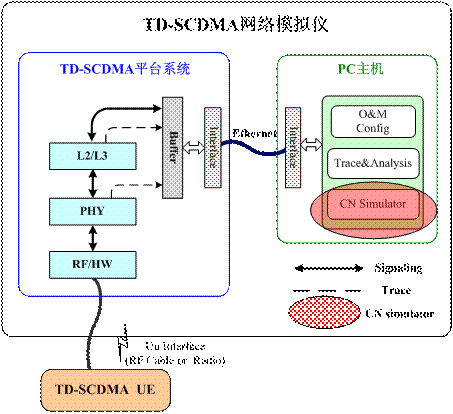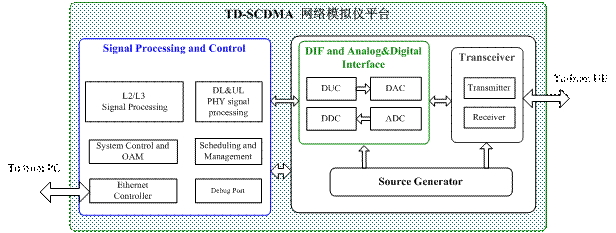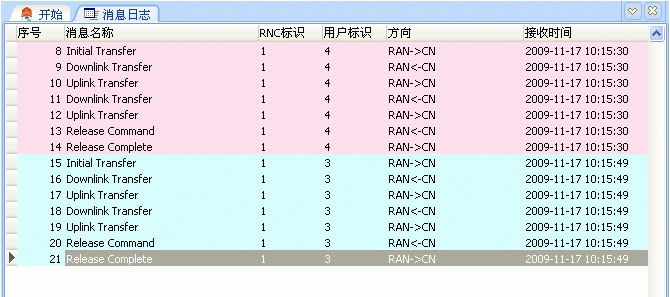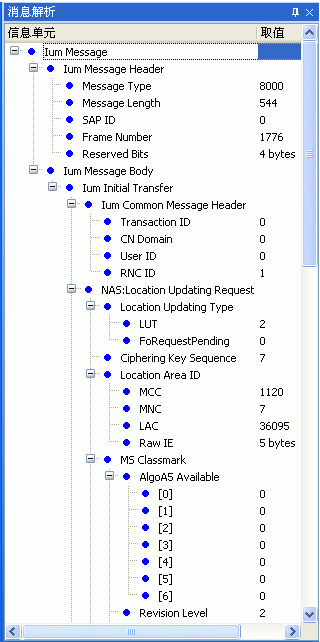Analysis of core network simulation function of TD-SCDMA network simulator
Analysis of core network simulation function of TD-SCDMA network simulator
Abstract: TD-SCDMA network simulator is the latest commissioning equipment with analog function of TD-SCDMA base station and core network. It not only supports terminal system-level functional testing, but also supports a separate core network simulation function part, which can provide a convenient debugging platform and means for the research and development of terminal chips and solutions. This article briefly introduces the principles and functions of the TD-SCDMA network simulator system and the core network simulation part.
1 Overview
With the continuous maturity and development of China's independently-innovated TD-SCDMA standards and technologies, especially the increasingly perfect TD-SCDMA network constructed by China Mobile, more and more companies are participating in the research and development of TD-SCDMA terminal chips and solutions. At present, since there are no instruments specifically developed and commissioned for TD-SCDMA terminals in the market, most enterprises basically rent or purchase commercial base stations and comprehensive test instruments to build development and test environments, which is not only expensive, but also has complicated parameter configuration and It is flexible and cannot meet the needs of the terminal's upstream data tracking (Trace) and analysis during the development process. The TD-SCDMA network simulator can provide an efficient and economic environment for terminal chip and product development, and solves the weak link in the development of TD-SCDMA terminals.
2. TD-SCDMA network simulator system composition
The TD-SCDMA network simulator is a product developed based on the 3GPP and CCSA standards, combined with FeitoCell's independent FemtoCell technology. It has the simulation function of TD-SCDMA base station platform and core network, supports terminal system-level functional testing, and can also provide commissioning means for terminal chip development. Its main functions include: L1 / L2 / L3 signaling tracking, debugging, playback; system upstream and downstream parameter configuration; support single-user and multi-user voice and data services and other related test cases.
TD-SCDMA network simulator consists of two parts: platform system and PC software. The platform system is connected to the PC through the Ethernet port.
The TD-SCDMA network simulator platform system mainly completes the signal processing on the TD-SCDMA base station side, and its function is equivalent to the base station equipment of TD-SCDMA. The hardware part provides a platform for TD-SCDMA wireless signal and baseband signal processing, including radio frequency transceiver, source generator, analog-to-digital / digital-to-analog conversion, digital intermediate frequency signal processing, baseband signal processing and other main functions; its system software refers to The software running on the hardware platform mainly completes the processing of TD-SCDMA L1 and access layer signaling, as well as the operation and maintenance of the hardware platform.
The PC software mainly completes the signaling processing function of the TD-SCDMA non-access layer, is responsible for the trace and monitoring of the information and signaling between the L1 / L2 / L3 layers, as well as configuring, data playback and analysis of the entire system, etc. Features. The "core network simulator" software part is one of the software running on the PC. Its functions include business simulation, upstream and downstream signaling monitoring analysis, core network parameter configuration, etc., which can be used for business support, signaling monitoring, comprehensive testing, etc. Many aspects. Figure 1 shows the position of the core network simulator in the TD-SCDMA network simulator.

Figure 1: The location of the core network simulator in the TD-SCDMA network simulator.
2.1 Platform system of TD-SCDMA network simulator

Figure 2: TD-SCDMA network simulator platform system.
TD-SCDMA network simulator platform system mainly includes three parts: hardware platform, physical layer PHY signal processing, TD-SCDMA high-level and application software signal processing, including:
The hardware subsystem provides a platform for TD-SCDMA wireless signal and baseband signal processing, including radio frequency transceivers, source generators, analog-to-digital / digital-to-analog conversion, digital intermediate frequency signal processing, and baseband signal processing.
PHY physical layer signal processing realizes the TD-SCDMA physical layer signal processing function defined by the 3GPP protocol.
TD-SCDMA high-level and application software signal processing to realize the functions of TD-SCDMA L2 and L3 defined by the 3GPP protocol, some functions of NAS, and control and scheduling of the hardware platform.
2.2 TD-SCDMA network simulator core network simulator function analysis
In the PC-side software, in addition to the platform operation and maintenance signaling analysis software, the most important part is the core network simulator software part. The core network simulator is a software that simulates the basic functions of the core network (CN) running on the PC. Its functions include service simulation, upstream and downstream signaling monitoring and analysis, and core network parameter configuration. It can be used for business support, signaling monitoring, and integration. Testing and many other aspects.
The main functions of the core network simulator are as follows:
1. Track all signaling transmitted on the Ium interface, including uplink and downlink signaling;
2. Ium message, NAS message signaling tracking and parsing functions. Can record and playback various signaling;
3. CS voice signaling plane and user plane functions;
4. Support mobility management functions, including MM entities supporting CS and GMM entities supporting PS;
5. Support connection management functions, including CC, SM entities, etc .;
6. Support upstream voice unidirectional playback;
7. Support CRBT voice function;
8. Support PS signaling plane function;
9. Support link detection function;
10. Support multiple RNC and multiple UE to work simultaneously;
11. Support the paging and service release functions initiated by CNSim;
12. Mainly supported configurations: basic parameters of the core network simulator, (for example: PLMN, HPLMN, UDP port and various timers, etc.); user information and can observe user status information (for example: registered users and activated users); Link detection time interval; RNC basic information; CRBT voice function, etc.
Example: Ium message tracking
Through the Ium message tracking window, you can track all the information interacting on the Ium interface, as shown in Figure 3:

Figure 3: Ium message tracking window.
The Ium message display window can display the entire content of each Ium message, as shown in Figure 4

Figure 4: Ium message IE display window.
It can be seen from the figure that this message is an initial direct message, and the NAS message carried is locaTIon updaTIng request. The values ​​of each IE of the message are also analyzed in detail, so that it is easy to judge whether the values ​​are reasonable, and then determine whether the terminal status and parameter settings are normal.
It can also be seen from the examples that the core network simulation part of the TD-SCDMA network simulator can provide detailed information related to the core network for terminal high-level protocol commissioning, and provide an effective means for L2 / L3 development of TD-SCDMA terminals.
3. Summary
This article can be seen through the introduction of the principles and functions of the TD-SCDMA network simulator and its main part "core network simulation", TD-SCDMA core network simulator can resolve the current high-level development of TD-SCDMA terminals and related products Problems such as lack of protocol debugging environment, complicated debugging means, inability to track and analyze upstream data, etc. will certainly play a positive role in promoting the development of TD-SCDMA terminal industry.
Depending on your location and budget Street Lighting Pole may include structures which are crafted from steel, aluminum, cement, wood or fiberglass.
Street Pole, street Lighting Pole
material: steel,Q235,SS400.
type:conical, octagonal, or polygonal ,mid-hinged ,taped and other shapes.
height:3-30m
Thickness:2-6mm
surface treatment: hot dip galvanization or hot dip galvanization and powder coated.
arm: single arm,double arms ,three arms or four arms.
Application: street ,road ,highway, park ,factory ,school and so on.
power souce: high pressure sodium light , metal halide light or flood light.or energy saving light.
Street Light Pole,Steel Lamp Pole,Street Pole,Street Lighting Pole
YIXING FUTAO METAL STRUCTURAL UNIT CO.,LTD( YIXING HONGSHENGYUAN ELECTRIC POWER FACILITIES CO.,LTD.) , https://www.chinasteelpole.com